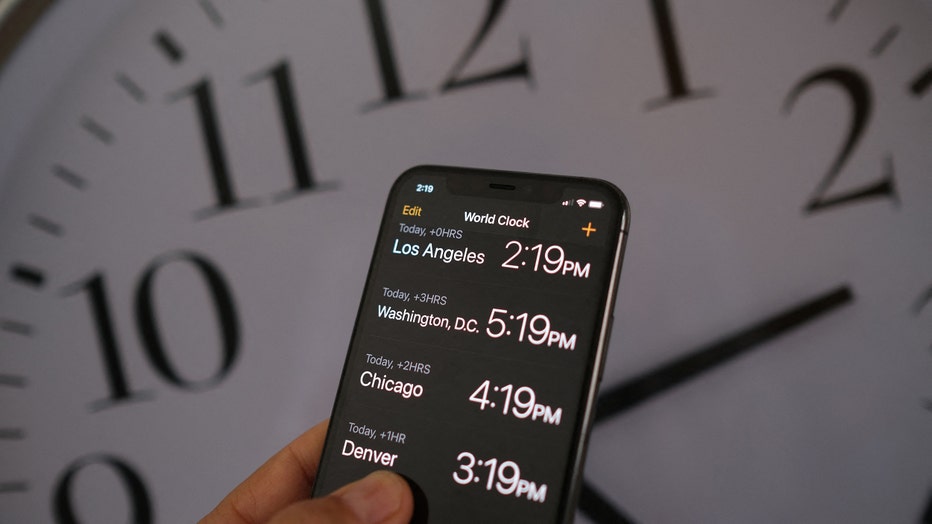Daylight saving time 2024: When is it and what to know about springing forward

Health risks and benefits of Daylight Saving Time
Brendan Duffy, Director at Catholic Health Sleep Services, explains the health risks and benefits of Daylight Saving Time. (FOX Weather)
Daylight saving time is coming to most parts of the United States soon, another stop on the road to spring.
You’ll lose an hour of sleep for one night, but the trade-off is more daylight.
Until daylight saving time ends early Nov. 3, the sun will rise later in the morning than it has during standard time – but it will stay light for longer in the evening.
What is Daylight saving time?
Daylight saving time is defined as a period between spring and fall when clocks in most parts of the country are set one hour ahead of standard time. According to federal law, it always starts on the second Sunday in March and ends on the first Sunday in November.
The practice of springing forward in the U.S. started in 1918 during World War I as a way to conserve fuel. By moving the clocks ahead an hour, backers believed the country could divert a bit of coal-fired electricity to the military instead of using it for an hour of home power. It was reenacted in World War II.

History of daylight saving time
Daylight saving time, or DST, was formally introduced in the U.S. in 1918 during World War I.
It was repealed again when the war ended, but some states — and even some cities — continued to observe daylight saving time while others kept standard time year-round. That meant driving relatively short distances could result in a time change.
By 1966, airlines and other businesses tired of such quirks and pushed Congress to pass the Uniform Time Act. It codified daylight saving time, although it has been modified periodically.
When is Daylight saving time 2024?
The transition to daylight saving time is official at 2 a.m. Sunday, March 10, across much of the country.
Then on March 19, winter sunsets and spring is sprung.
Which states don’t observe Daylight Saving Time?
Daylight Saving Time happens in the vast majority of the United States, but not everywhere.
No time change is observed in Hawaii, most of Arizona, Puerto Rico, the U.S. Virgin Islands, American Samoa, Guam and the Northern Marianas.
Will we ever stop switching between standard and Daylight Saving Time?

Daylight saving time 2024 is on March 10 (Photo by CHRIS DELMAS/AFP via Getty Images)
A poll conducted in October 2021 found that most people in the United States want to avoid switching between daylight saving and standard time, though there is no consensus behind which should be used all year.
The poll from The Associated Press-NORC Center for Public Affairs Research found only 25% of those questioned said they preferred to switch back and forth between standard and daylight saving time. Forty-three percent said they would like to see standard time used during the entire year. Thirty-two percent said they would prefer that daylight saving time be used all year.
Which states want to make daylight saving time permanent?
According to the National Conference of State Legislatures, 20 states have enacted legislation or passed resolutions to make daylight saving time permanent pending congressional approval. In some states, their law is dependent on surrounding states enacting the same law.
The 20 states that have voted in favor of year-round daylight saving time are:
- Alabama
- California
- Colorado
- Delaware
- Florida
- Georgia
- Idaho
- Kentucky
- Louisiana
- Maine
- Minnesota
- Mississippi
- Montana
- Ohio
- Oregon
- South Carolina
- Tennessee
- Utah
- Washington
- Wyoming
What’s the status of the Sunshine Protection Act?
There’s a growing movement to make daylight saving time permanent, and a bill introduced in Congress in 2022 would do just that.
The bill, named the Sunshine Protection Act, would ensure Americans would no longer have to change their clocks twice a year. The goal was to enact said bill by 2023, but things haven’t really gone according to plan.
U.S. Sen. Marco Rubio of Florida introduced the Sunshine Protection Act in the Senate, while U.S. Rep. Vern Buchanan, also a Florida Republican, introduced a version of the bill in the House.
According to The Hill, the Senate bill has been read twice and referred to a committee, while the House bill has only been referred to a subcommittee.
FOX’s Chris Williams, Catherine Stoddard and The Associated Press contributed to this report.


